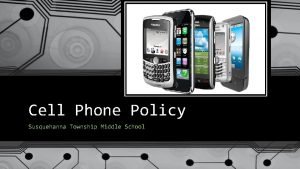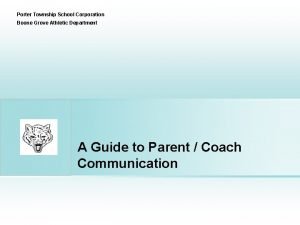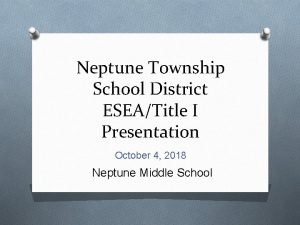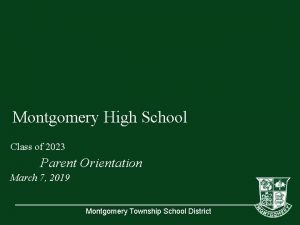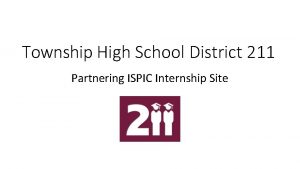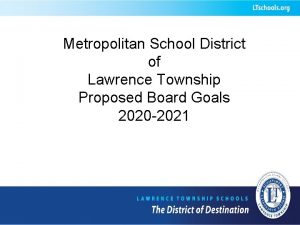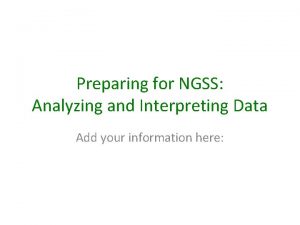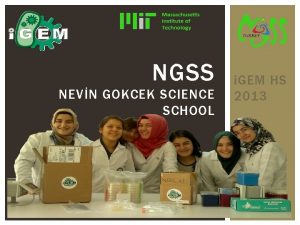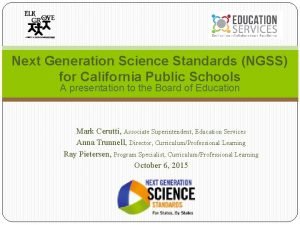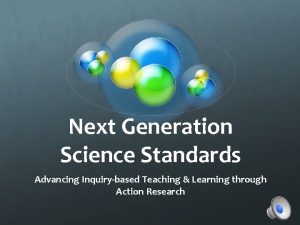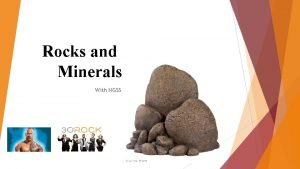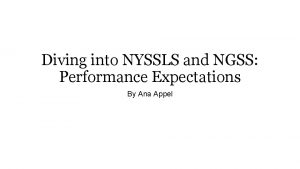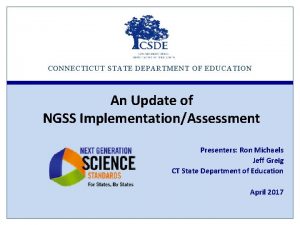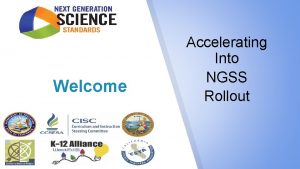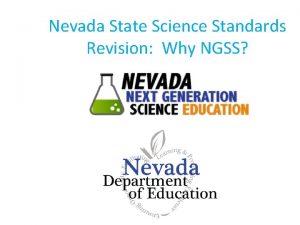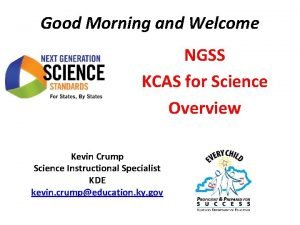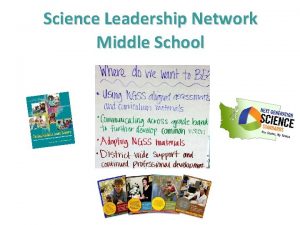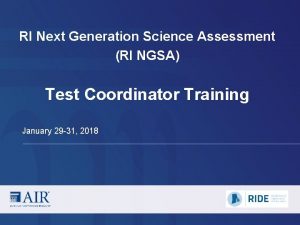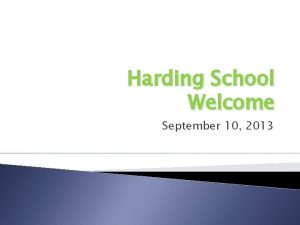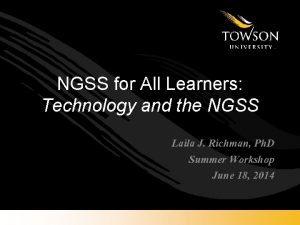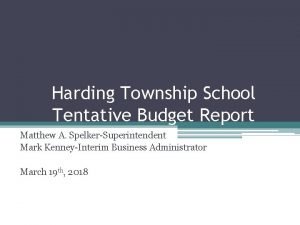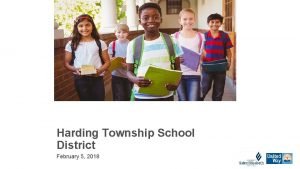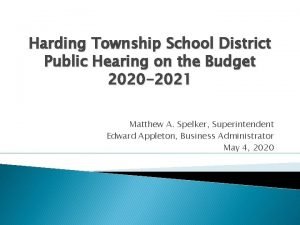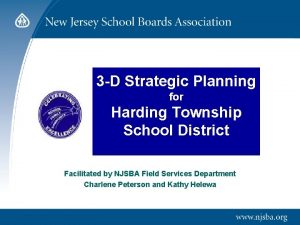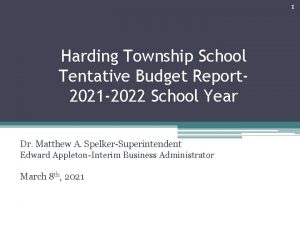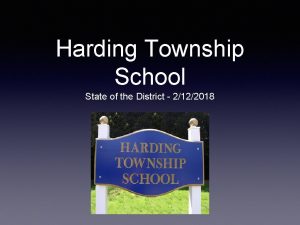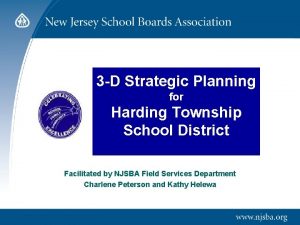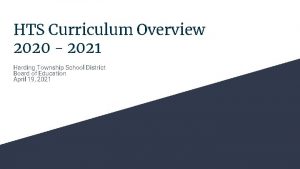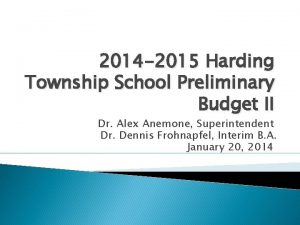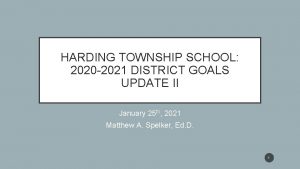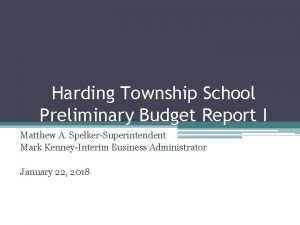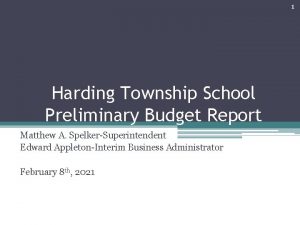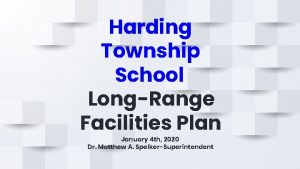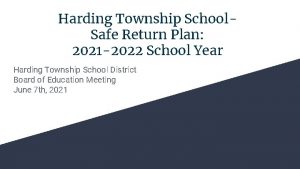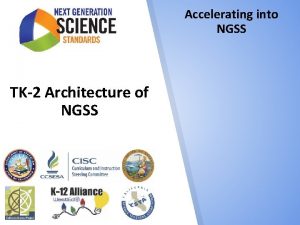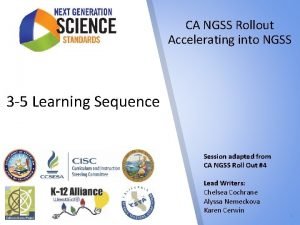NGSS and Harding Township School Presented to the




















- Slides: 20

NGSS and Harding Township School Presented to the BOE on February 8, 2016 Dr. Michael Gervis Middle School Science Supervisor

Origin of the Next Generation Science Standards • A group of 26 lead states participated in the development • Participants included representatives from colleges, elementary and secondary education. • Based on the National Research Council’s A Framework for K-12 Science Education • Partners include National Research Council, National Science Teachers Association, American Association for the Advancement of Science, Achieve • Sponsors include The Cisco Foundation, GE Foundation, Carnegie Foundation of New York, Du. Pont

NGSS Trivia • Was NGSS a Federal initiative? • The federal government was not involved in this effort and did not fund it. • Who funded NGSS? • The work undertaken by the NRC and Achieve was being supported by the Carnegie Corporation of New York. • Who Developed NGSS? • • • It was state-led, and states will decide whether or not to adopt the standards. Achieve oversaw the process. Professional organizations (like ASSS, NSTA), teachers, scientists, engineers, etc. were heavily involved in development. • Was the public (teachers or stake holders) involved in the process of creating NGSS? • The first two drafts were released to the public. The final draft responded to public feedback. • Lead States provided invaluable feedback throughout the process.

Principles in the Framework • Children are born investigators • Understanding builds over time • Science and engineering require both knowledge and practice • Connecting to students’ interest and experiences is essential • Focusing on core ideas and practices • Promoting equity

Structure of the Framework The Three Dimensions: Practices Core Ideas (Content) Crosscutting Concepts

Content and Practice Work together to Build Understanding • Scientific ideas are best learned Practices when students engage in practices • To form useable understanding, knowing and doing cannot be separated, but rather must be learned together • Allows for problem-solving, decisions making, explaining realworld phenomena, and integrating new ideas Crosscutting Concepts Core Ideas

Scientific & Engineering Practices: 1. Asking questions (science) and defining problems (engineering) 2. Developing and using models 3. Planning and carrying out investigations 4. Analyzing and interpreting data 5. Using mathematical and computational thinking 6. Developing explanations (science) and designing solutions (engineering) 7. Engaging in argument from evidence 8. Obtaining, evaluating and communicating information

Crosscutting Concepts 1. 2. 3. 4. 5. 6. 7. Patterns Cause and effect Scale, proportion and quantity Systems and system models Energy and matter Structure and function Stability and change

Disciplinary Core Ideas Life Science Physical Science LS 1: From Molecules to Organisms: Structures and Processes PS 1: Matter and Its Interactions LS 2: Ecosystems: Interactions, Energy, and Dynamics LS 3: Heredity: Inheritance and Variation of Traits PS 2: Motion and Stability: Forces and Interactions PS 3: Energy PS 4: Waves and Their Applications in Technologies for Information Transfer LS 4: Biological Evolution: Unity and Diversity Earth & Space Science Engineering & Technology ESS 1: Earth’s Place in the Universe ETS 1: Engineering Design ESS 2: Earth’s Systems ETS 2: Links Among Engineering, Technology, Science, and Society ESS 3: Earth and Human Activity

Math Science M 4. Models with mathematics S 2: Develop & use models S 5: Use mathematics & computational thinking S 1: Ask questions and define problems S 3: Plan & carry out investigations S 4: Analyze & interpret data E 2: Build a strong base of knowledge S 6: Construct explanations & through content rich texts design solutions E 5: Read, write, and speak grounded in evidence S 8: Obtain, M 3 & E 4: Construct viable evaluate, & arguments and critique communicate reasoning of others information S 7: Engage in E 3: Obtain, synthesize, argument from M 5: Use appropriate and report findings clearly evidence tools strategically and effectively in response M 1: Make sense of problems and persevere in solving them M 2: Reason abstractly & quantitatively M 6: Attend to precision M 7: Look for & make use of structure M 8: Look for & E 6: Use make use of technology regularity & digital media in repeated strategically & reasoning capably to task and purpose E 1: Demonstrate independence in reading complex texts, and writing and speaking about them E 7: Come to understand other perspectives and cultures through reading, listening, and collaborations Commonalities Among the Practices in Science, Mathematics and English Language Arts ELA Based on work by Tina Chuek ell. stanford. edu

Connections to Common Core • NGSS align grade by grade with CCSS • Connections to specific CCSS are listed for each NGSS expectation giving teachers a blueprint for building comprehensive cross-disciplinary lessons • Intersections teach students to: – analyze data – model concepts – strategically use tools to productive talk and shared activity

Putting It All Together: What Does It Look Like?

An Example Middle School: Chemical Reactions

How is NGSS different from previous standards? What does it mean to learn that “matter is made of molecules”? Current state standard NGSS Performance expectation ■ Students know all matter is made of atoms, which may combine to form molecules. ■ Develop a model to describe that matter is made of particles too small to be seen. 5 th grade state standard 5 th grade NGSS performance expectation 5 -PS 1 -1

Middle School Comparison Current State Middle School Science Standard • Distinguish between atoms & molecules • Describe the difference between pure substances and mixtures • Describe the movement of particles in solids, liquids, gases and plasma states • Distinguish between the physical and chemical properties of matter • Distinguish between changes in matter as physical or chemical • Recognize that there are more than 100 elements and some have similar properties NGSS Middle School Sample • • Construct and use models to explain that atoms combine to form new substances of varying complexity in terms of the number of atoms and repeating subunits Plan investigations to generate evidence supporting the claim that one pure substance can be distinguished from another based on characteristic properties Use a simulation or mechanical model to determine the effect of temperature and motion of atoms Construct an argument that explains the effect of adding/removing a substance in different phases & during a phase change in terms of atomic and molecular motion

The Old and The New

Instructional Shifts in NGSS • K – 12 science education should reflect the real world interconnections in science • NGSS focuses on deeper understanding and application of content • Standards are expressed as performance expectations – students must demonstrate knowledge in-use • Standards articulate a clear vision of the learning goals for students

Inquiry vs. Practices Inquiry Practice Science classrooms are environments where students learn about science ideas Science classrooms are environments where students explore, examine and use science to explain how and why phenomena occur

Looking Ahead Lots of work completed, underway, and left to do Assessments Curricula Instruction Completed! Completed Teacher development

NGSS & HTS Implementation Achieved To Date: • Coordination with Madison Supervisor of Science and Technology • Monthly meetings with High School and Middle School Science Teachers • Sessions at Madison Teaching Academy • NJ DOE Conference • In-House Science Committee meetings • Coordination with Madison Elementary Science Committee Next Steps: • Coordinate with Madison to research and purchase appropriate resources • Coordinate with Madison to develop curriculum • Middle School implementation: September 2016 • Elementary School Implementation: September 2017 • Teacher training
 Southampton township school district
Southampton township school district Susquehanna township middle school
Susquehanna township middle school Boone grove athletics
Boone grove athletics Neptune township school
Neptune township school Heather pino-beattie
Heather pino-beattie Lyons township high school demographics
Lyons township high school demographics Zlatožlutý sulfid
Zlatožlutý sulfid Lawrence township school board
Lawrence township school board Ngss analyzing and interpreting data
Ngss analyzing and interpreting data Nedir
Nedir Hs2 ngss
Hs2 ngss Ngss california
Ngss california Ngss inquiry based learning
Ngss inquiry based learning Rock cycle ngss
Rock cycle ngss Performance expectations ngss
Performance expectations ngss Ngss practice test ct
Ngss practice test ct Welcome to ngss
Welcome to ngss Nevada state science standards
Nevada state science standards Welcome to ngss
Welcome to ngss Ngss lesson screener
Ngss lesson screener Ngsa assessment
Ngsa assessment

